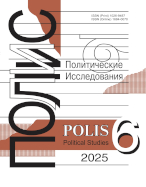“Rally Around the Flag” Effect. How and Why Support of the Authorities Grows During International Conflicts and Tragedies?
Kazun A.D.,
Cand. Sci. (Soc.), Senior Research Fellow at Laboratory for Studies in Economic Sociology, Associate Professor at the Faculty of Social Sciences, HSE University, Moscow, Russia, adkazun@hse.ru
elibrary_id: 822971 | ORCID: 0000-0002-9633-2776 | RESEARCHER_ID: K-6835-2015
DOI: 10.17976/jpps/2017.01.12
Kazun A.D. “Rally Around the Flag” Effect. How and Why Support of the Authorities Grows During International Conflicts and Tragedies? – Polis. Political Studies. 2017. No. 1. https://doi.org/10.17976/jpps/2017.01.12
Numerous studies of support of national leaders indicate that the President’s approval ratings increase substantially during international conflicts and tragedies. In such a way, the Falklands War greatly influenced the popularity of Margaret Thatcher. The Gulf War led to a significant increase in the public approval of George H.W. Bush, and the terrorist attack of 9/11 was a push for greater support for George W. Bush. The article analyzes the phenomenon of consolidation of the population around a national leader in times of crisis, called “rally around the flag”. We systematize the literature on the subject and draw conclusions on a number of fundamental premises of the theory. Thus, the circumstances under which this effect takes place must meet the following criteria: relevance to society as a whole, the international level, suddenness of the event, the direct participation of the President in solving the problem and the existence of personified “other”. The emergence of rally effect is closely connected with characteristics of media coverage of the issues and patriotism of the population. The article also notes that, despite the considerable scale that this effect can reach (up to 35% of approval rating), the duration of its preservation is not so large (up to six months). It reduces the temptation for the authorities to provoke conflicts with the purpose of acquiring more public support.
References
Allen B., O’Loughlin P., Jasperson A., Sullivan J.L. The Media and the Gulf War: Framing, Priming, and the Spiral of Silence. – Polity. 1994. No. 27. P. 255‑284.
Baum M.A. The Constituent Foundations of the Rally-Round-the-Flag Phenomenon. – International Studies Quarterly. 2002. No. 2. P. 263‑298.
Bennett E. Terrorist Attacks & Presidential Approval Rating. – Politikon. 2014. No. 22. P. 27‑44.
Blumer G. Social Problems as Collective Behavior. – Social Problems. 1971. Vol. 18. P. 298‑306.
Bolz N. Das ABC der Medien. (Russ. ed.: Bolz N. Azbuka Media. M.: Evropa. 136 p.)
Brody R. Assessing the President: The Media, Elite Opinion, and Public Support. Stanford, California: Stanford University Press. 1991. 202 p.
Chowanietz C. Rallying Around the Flag or Railing Against the Government? Political Parties’ Reactions to Terrorist Acts. – Party Politics. 2011. No. 17. P. 673‑698.
Dinesen P.T., Jæger M.M. The Effect of Terror on Institutional Trust: New Evidence from the 3/11 Madrid Terrorist Attack. – Political Psychology. 2013. No. 34. P. 917‑926.
Edwards G.C., Swenson T. Who Rallies? The Anatomy of a Rally Event. – The Journal of Politics. 1997. No. 1. P. 200‑212.
Fan D. Predictions of Public Opinion from the Mass Media: Computer content analysis and mathematical modeling. New York: Greenwood Press. 1988. 228 p.
Fiorina P.M. Electoral Politics in the Wake of 9/11. – American Government in a Changed World. N.Y.: Longman Publishing Group. 2002. P. 115‑129.
Hirt N. The Eritrean Diaspora and Its Impact on Regime Stability: Responses to UN Sanctions. – African Affairs. 2015. No. 114. P. 115‑135. DOI: https://doi.org/10.1093/afraf/adu061
Kazun A.D. Framing Sanctions in the Russian Media: The Rally Effect and Putin’s Enduring Popularity. – Demokratizatsiya: The Journal of Post-Soviet Democratization. 2016. Vol. 24. No. 3. P. 327‑350.
Miller D.B. The Morality Play: Getting to the Heart of Media Influence on Foreign Policy. – Journalism Studies. 2010. No. 11. P. 718‑733.
Mueller J.E. American Public Opinion and the Gulf War: Some Polling Issues. – Public Opinion Quarterly. 1993. No. 57. P. 80‑91. DOI: https://doi.org/10.1086/269356
Mueller J.E. War, Presidents and Public Opinion. N.Y.: John Wiley & Sons Inc. 1973. 326 p.
Mueller J.E. Presidential Popularity from Truman to Johnson. – The American Political Science Review. 1970. No. 64. P. 18‑34. DOI: https://doi.org/10.2307/1955610
Nam T. Rallying Around the Flag or Crying Wolf? Contentions over the Cheonan Incident. – Asian Perspective. 2015. No. 39. P. 221‑251.
Newman B., Forcehimes A. “Rally Round the Flag” Events for Presidential Approval Research. – Electoral Studies. 2010. No. 29. P. 144‑154. DOI: https://doi.org/10.1016/j.electstud.2009.07.003
Noelle-Neumann E. The Spiral of Silence. A Theory of Public Opinion – Our Social Skin. Chicago: University of Chicago Press. 1984. 277 p.
Norrander B., Wilcox C. Rallying around the Flag and Partisan Change: The Case of the Persian Gulf War. – Political Research Quarterly. 1993. No. 46. P. 759‑770. DOI: https://doi.org/10.1177/106591299304600404
Ogden C. Maggie: An Intimate Portrait of a Woman in Power. Simon & Schuster. 1990. 544 p.
Peksen D. Coercive Diplomacy and Press Freedom: An Empirical Assessment of the Impact of Economic Sanctions on Media Source. – International Political Science Review. 2010. No. 4. P. 449‑469. DOI: https://doi.org/10.1177/0192512110372610
Perrin A.J., Smolek S.J. Who Trusts? Race, Gender, and the September 11 Rally Effect Among Young Adults. – Social Science Research. 2009. No. 38. P. 134‑145. DOI: https://doi.org/10.1016/j.ssresearch.2008.09.001
Robbins J., Hunter L., Murray G.R. Voters Versus Terrorists: Analyzing the Effect of Terrorist Events on Voter Turnout. – Journal of Peace Research. 2013. No. 50. P. 495‑508. DOI: https://doi.org/10.1177/0022343313479814
Ruffini G. Press Failed to Challenge the Rush to War. – The Media and the Gulf War. Washington, DC: Seven Locks Press. 1992. P. 282‑292.
Skocpol T. Will 9/11 and the War on Terror Revitalize American Civic Democracy. – PS: Political Science and Politics. 2002. No. 35. P. 537‑540. DOI: https://doi.org/10.1017/S104909650200080X
Spector M., Kitsuse J.I. Constructing Social Problems. New York: Aldine de Groyter. 1987. 184 p.
Tir J., Singh S.P. Is It the Economy or Foreign Policy, Stupid? The Impact of Foreign Crises on Leader Support. – Comparative Politics. 2013. No. 46. P. 83‑101. DOI: https://doi.org/10.5129/001041513807709374
See also:
Bezvikonnaya Ye.V.,
Systemico-Synergetic Model of a Political System. – Polis. Political Studies. 2009. No3
Bernays E.L.,
Manipulating public opinion: the why and the how. – Polis. Political Studies. 2012. No4
Shcheblanova V.V., Surkova I.Yu.,
Counter-terrorism operations: motivation, estimations and prospects. – Polis. Political Studies. 2013. No3
Rozov N.S.,
Crisis and Revolutions: Fields of Interaction, Actors’ Strategies, and Trajectories of Conflict Dynamics. – Polis. Political Studies. 2017. No6
Oznobishchev S.K.,
“The New Cold War”: Reminiscences about the Future. – Polis. Political Studies. 2016. No1




.jpg)






 print
print
.jpg)
.jpg)